Please put an active hyperlink to our site (www.rusnature.info) when you copy the materials from this page
Environmental problems of Northern Eurasia
Radioactive Contamination
<<< Tomsk and Krasnoyarsk | Environmental Problems Index | Contamination
Concerns in the Arctic Region >>>
The Semipalatinsk Test Site
The third major area of contamination in the former Soviet republics, and certainly the
most contaminated portion of Central Asia, is around the nuclear weapons test site in
Kazakhstan (Figure 19.1).

Fig. 19.1 Radioactive waste and contamination in the former Soviet
republics. After Pryde and Bradley (1994)
This testing range covered some 18 000 square km at a location about 200 km west of the
city of Semey (formerly Semipalatinsk). A total of 467 nuclear blasts were carried out
here, including atmospheric explosions from 1949 to 1963. The test site was closed by the
newly independent Kazakhstan government in 1991.
There is extensive surface radioactive contamination at, and around, the Semipalatinsk
test site. Twenty-four of the above ground tests there resulted in radioactive
contamination being deposited far beyond the boundaries of the test site (Bradley, 1997).
Measurements of caesium-137 in the soil at the detonation craters showed concentrations
similar to Chernobyl after the 1986 accident. A special commission found that 10 000 of
the 70 000 local residents had received elevated radiation doses from the tests, primarily
during the pre-1963 atmospheric testing period. Reportedly, 900 residents of the village
of Dolon received extreme doses of up to 160 rem (Nucleonics Week, 7 November 1991).
The contaminated area extends well beyond the boundaries of the test site. On
twenty-two occasions, nuclear tests produced measurable fallout over Russia's adjacent
Altay territory. Over a million people still live in contaminated areas. Additionally,
from 1961 to 1969, 'about 38 000 curies of radioactive strontium and almost 50 000 curies
of caesium were introduced into the Irtysh river' (Bradley, 1997).
The Semipalatinsk testing region was examined by an IAEA team in 1994, and most of the
area was considered as posing no health risk at that time to local populations. Two
portions of the range still require controlled access, however, and a total of 720 km2
are 'too contaminated for human use' (Bradley, 1997).
<<< Tomsk and Krasnoyarsk | Environmental Problems Index | Contamination
Concerns in the Arctic Region >>>
Contents of the Radioactive Contamination
section:
Other sections of Environmental Problems of Nortern Eurasia:
|
|